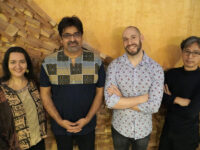Yesterday, Atlanta, GA bassist Michael Feinberg put out his second album, With Many Hands, a part of a quiet revolution taking place in jazz today. The twenty-somethings like Feinberg and his band who are plying their trade in this hallowed American institution of jazz didn’t grow up listening to only Armstrong, Parker and Davis records. Like everyone else of their generation, they filled their ears with heaping helpings of alt rock, hip hop, electronica and ethnic fusion. The best of these youngest of lions have learned to distill the influences of their music’s generation in a nuanced manner that pushes jazz along an evolutionary path without crapping all over the beautiful things done in this idiom by older generations. With Many Hands is one of several records out in the last few years that are pretty easy to accept by tradition-minded tastes, but like a Trojan horse, will end up changing jazz in the longer term, or at least nudge it outside of its shell.
Some bass player’s albums center around the bass player’s instrumental prowess (think Stanley Clarke), others are about bass players who can sing (think Esperanza Spalding), and others follow in the tradition of Charles Mingus, who blazed the trail for bass players as great composers and bandleaders. Feinberg takes the Mingus route. Though he leads a much smaller ensemble, ranging from a quartet to a sextet depending on the song’s requirements, With Many Hands is a record not so much about individual performances (not that they aren’t good, they are), it’s an emphasis on the ensemble product.
Hands consists of a rhythm section throughout of himself, drummer Daniel Platzman and pianist Julian Shore (Gretchen Parlato). The revolving front line most of time has tenor saxophonist Noah Preminger and alto saxman Godwin Louis making the noise on top, with Alex Wintz providing guitar for a few tracks. Preminger, is an exciting young leader in his own right, as we saw in sizing up his new Before The Rain release earlier this year.
The title track that begins this album is a coiling, reserved composition that brings to mind the urbane blue moods of Blue Note-era Wayne Shorter. Though Feinberg delegates focal points to his bandmates generously — everyone gets a chance to shine on this song, and they do — Feinberg’s presence can be felt on every rounded, well placed note generated from his double-bass. Even when he solos, he does so to articulate the melody, which is nuanced and compelling enough to justify his approach. Moreover, the delicate modulation of the performance, the subtly adjusting moods, amplifies the impressionistic character already present from the song. Using the traditional two-horn quintet configuration, “With Many Hands” is a impressive reading of 1960s modern jazz.
“Temple Tales” relies on a ominous, circular bass line, Shore’s electric piano, and the addition of Wintz’s rock-ish guitar to get an entirely different point across, folding in non-jazz elements into jazz while still remaining entirely respectful of jazz tradition. Preminger’s impassioned solo is the high point here. “NBD” is a return to the slightly doleful mood of the first track, and appeals in much the same way, with Shore’s measured musings giving the song a real lift. “The Hard Stuff” more explicitly injects rock elements, with both Shore’s Rhodes and Wintz’s guitar sounding more menacing than before, but all the freedom found in jazz is still allowed, and Preminger and Wintz improvise simultaneously over Platzman’s shuffling rhythms.
A softer electric piano and guitar are employed for the ballad “August,” which leaves the horns completely out. In doing so, Feinberg brings out the mysterious, delicate melodic lines, and Wintz’s toned down notes deftly resolves challenges set up by the composition. Here again, Feinberg solos in a most unobtrusive way, and again, it’s appropriate because the melody needs minimal interference. “Fighting Monsters” features terrific coaction between Preminger and Louis, where the two even finish each others’ lines in the chorus. During the improvisation sections, they trade off short solos, daring each other to raise their games. The melody underneath is clearly rooted in the bop tradition, but the chord changes have a more modern flavor to them. “Lost And Found” is a great way to end an album like this. An unabashedly pure bop tune full of charged bombs and fills by Platzman and soul-stirring sax honking by Louis, Feinberg sends the message that just because he has been making tweaks to straight jazz doesn’t mean he doesn’t love jazz as-is.
With Many Hands might only be this twenty-four year old’s second album, but Feinberg has already found his footing. This record offers much hope that then next generation of jazz leaders are going to be just as exciting, dynamic and creative as the generations before them.
Pay a visit to Michael Feinberg’s site here.
[amazon_enhanced asin=”B004MFJB68″ /] [amazon_enhanced asin=”B004MFPKOK” /] [amazon_enhanced asin=”B004FCFYLO” /] [amazon_enhanced asin=”B004ALIFZM” /]
- How Norah Jones Continued to Push Against Convention With ‘The Fall’ - November 23, 2024
- McCoy Tyner and Joe Henderson – ‘Forces of Nature: Live at Slugs’ (2024) - November 21, 2024
- Lydia Salnikova, “Christmas Means a Different Thing This Year” (2024): One Track Mind - November 19, 2024



